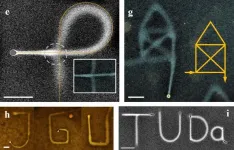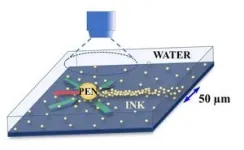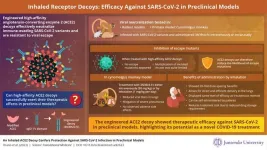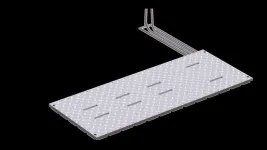(Press-News.org) Writing is an age-old cultural technique. Thousands of years ago, humans were already carving signs and symbols into stone slabs. Scripts have become far more sophisticated since then but one aspect remains the same: Whether the writer is using cuneiform or a modern alphabet, a solid substrate, such as clay or paper, is required to fix the written structures in place. However, researchers at Johannes Gutenberg University Mainz (JGU), TU Darmstadt, and Wuhan University asked themselves how to write in a bulk fluid like water without fixing substrates. The concept would not be unlike the way aircraft leave three-dimensional vapor trails behind them when they cross the sky – compared to two-dimensional writing with a pen on dry paper. When you dip the nib of a fountain pen in water and try to write something with it in the water, you will, of course, have little success. The movement of the relatively large nib through the water creates turbulence that will eventually eradicate any ink traces left behind. But as the Reynolds number, i.e., the factor used to calculate fluid flow, indicates: The smaller the moving object, the lower the number of vortices it will create. However, to take advantage of this, a truly minute pen would be needed and this would require a massive reservoir of ink that would cancel out the effect of the tiny pen.
An ion-exchange bead serving as a pen
The team of researchers decided to adopt a completely new strategy to overcome this inherent problem: "We have put the ink directly in the water and use a microbead made of ion-exchange material with a diameter of 20 to 50 microns as a writing instrument," explained Professor Thomas Palberg of JGU. This bead is so small that it generates no vortices at all. The clever bit is that the bead exchanges residual cations in the water for protons, thus altering the local pH value of the water. If the bead is rolled across the base of a water bath, it traces out an invisible track of lower pH in the liquid. This attracts the ink particles and they accumulate in the path marked out by the ball point. The result is a fine line of just a few hundredth microns in width, marking out the area of the lowest pH value.
To actually write a letter in water, you just need to tilt the water bath in such a way that the bead moves to outline the required character. "During our first attempts, we moved the water bath by hand but we have since constructed a programmable rocker," Palberg continued. "In a water bath no bigger than a one Euro coin, we were able to produce a simple house-like pattern in the size of the tittle of an 'I' character in an 18 point font, and then viewed this under the microscope. But we are still only in the preliminary phase." Any kind of written form that can be produced using continuous lines can be readily reproduced, as other simulations have shown. Moreover, interruptions, such as breaks between separate letters, could also be achieved because, for example, the ion exchange process could be switched on and off at will using light exposure techniques. Even erasure and correction of what has been written is possible.
A non-specific effect that can be used in various ways
Professor Benno Liebchen and Lukas Hecht of TU Darmstadt have developed a theoretical model that explains the mechanism that makes writing in water viable. The corresponding simulations have demonstrated that this mechanism is a generic, non-specific effect and could thus be employed in a wide variety of forms, according to Liebchen, who is head of the Theory of Soft Matter group at the Institute for Condensed Matter Physics (IPKM) at TU Darmstadt. "In addition to beads made of ion exchange resins, 'pens' consisting of particles that can be heated by lasers could be employed or even individually steerable microswimmers," he noted. "This could even allow extensive parallel writing of structures in water. Hence, the mechanism could also be used to generate highly complex density patterns in fluids."
An important implication of the theoretical simulations is that this new form of writing is not constrained by the need for a base to the fluid container because the effect is non-specific as to where it occurs in the liquid. It would be sufficient if the ink was rapidly transported to the 'written' outlines and these would only disappear by means of diffusion to make sure the lines remain clearly visible for about ten minutes. Using 'adhesive' UV-sensitive inks, it might even prove possible to fix lines and lettering in place for longer. There are many potential variations that could be realized by means of using different components in the form of the writing instrument, type of drawn trail, ink, or form of steering employed. One option would be to use fluorescent ink and several very lightweight writing beads that could be moved through the fluid in three dimensions with the help of optical tweezers. This would result not only in luminescent shapes but could also be used for the 3D structuring of fluids. "Our new approach is very robust and has the potential for extreme modularity," emphasized Palberg. "And it can be developed in an exceptionally wide range of different ways."
The researchers have recently published a paper on their findings in Small.
Joint research undertaken by the Rhine-Main Universities
The research project was a joint effort of the Rhine-Main Universities (RMU), a strategic alliance consisting of Goethe University Frankfurt, Johannes Gutenberg University Mainz, and TU Darmstadt – three prestigious, research-led universities. The RMU framework agreement, signed in December 2015, extended the long-standing partnership and made the collaboration into a strategic alliance designed to promote the research undertaken by the universities, improve the shared courses on offer, and enhance knowledge transfer and networking with society in general.
Related links:
https://www.komet.physik.uni-mainz.de/ – Condensed Matter Physics at the JGU Institute of Physics
:
https://press.uni-mainz.de/material-design-by-means-of-defect-engineering-german-research-foundation-approves-new-collaborative-research-center-at-mainz-university/ – press release "Material design by means of defect engineering: German Research Foundation approves new Collaborative Research Center at Mainz University" (25 May 2023)
https://press.uni-mainz.de/third-funding-period-for-collaborative-research-center-investigating-soft-matter-simulation/ – press release "Third funding period for collaborative research center investigating soft matter simulation" (9 June 2022)
https://press.uni-mainz.de/german-research-foundation-approves-new-research-training-group-on-the-self-organization-of-soft-matter/ – press release "German Research Foundation approves new research training group on the self-organization of soft matter" (25 Nov. 2019)
https://press.uni-mainz.de/mainz-based-physicists-find-missing-link-between-glass-formation-and-crystallization/ – press release "Mainz-based physicists find missing link between glass formation and crystallization" (1 July 2016) END
How to write in water?
Researchers at Mainz University, TU Darmstadt, and Wuhan University overcome fundamental obstacles for writing and drawing lines, letters, and complex patterns within the bulk of a liquid
2023-08-30
ELSE PRESS RELEASES FROM THIS DATE:
Stanford Medicine-led study finds genetic factor fends off Alzheimer’s and Parkinson’s
2023-08-30
About one in every five people carries a version of a gene that, although largely unsung, appears to confer protection against both Alzheimer’s disease and Parkinson’s disease, Stanford Medicine investigators and their colleagues have learned. These lucky people may someday benefit all the more from a vaccine that could slow or stall the progression of these two most common neurodegenerative conditions.
An analysis of medical and genetic data from hundreds of thousands of people of diverse ancestries from several continents has revealed ...
First-time fathers seem to experience a steeper decline in relationship satisfaction in the first two years post-partum than second-time fathers
2023-08-30
First-time fathers seem to experience a steeper decline in relationship satisfaction in the first two years post-partum than second-time fathers, who appear to recover lost relationship satisfaction by the time their second child is 14 months old, according to a study published August 30, 2023 in the open-access journal PLOS ONE by Judith T. Mack and Lena Brunke from Technische Universität Dresden, Germany, and colleagues.
Having a strong primary relationship can help couples more successfully weather potentially-challenging transitions like the birth of a child. Most research on ...
Detailed analysis of two Late Bronze Age urn burials uncovers animal bones and jewelry amidst the cremated remains of a woman and child, and reveals insights into prehistoric funerary rites
2023-08-30
Detailed analysis of two Late Bronze Age urn burials uncovers animal bones and jewelry amidst the cremated remains of a woman and child, and reveals insights into prehistoric funerary rites
###
Article URL: https://journals.plos.org/plosone/article?id=10.1371/journal.pone.0289140
Article Title: More than urns: A multi-method pipeline for analyzing cremation burials
Author Countries: Austria, Slovakia, Czech Republic, Belgium
Funding: This study was funded by the Austrian Science Fund (FWF) in the framework of the project ‘Unlocking the secrets ...
Antibody shows promise for preventing organ rejection after transplantation
2023-08-30
DURHAM, N.C. – A man-made antibody successfully prevented organ rejection when tested in primates that had undergone a kidney transplant, Duke Health researchers report.
The finding clears the way for the new monoclonal antibody to move forward in human clinical trials. Results of the study appear online Aug. 30 in the journal Science Translational Medicine.
“Current medications to prevent organ rejection are good overall, but they have a lot of side effects,” said lead author Imran J. Anwar, M.D., a surgical research fellow ...
New blood test detects a key indicator of Parkinson’s disease
2023-08-30
DURHAM, N.C. – Researchers have developed a blood test that detects Parkinson’s disease, potentially establishing a way to help diagnose the condition before nervous system damage worsens.
A new blood-based diagnostic test would be a major advancement for Parkinson’s disease, which afflicts 10 million people worldwide and is the second-most common neurodegenerative disease after Alzheimer’s. Led by a team of Duke Health neuroscientists, the study appears Aug. 30 in the journal Science Translational Medicine.
“Currently, Parkinson’s disease is diagnosed largely based on clinical symptoms after significant neurological damage has ...
Inhaled receptor decoy therapy for COVID-19 in preclinical models
2023-08-30
The surface protein of the severe acute respiratory syndrome coronavirus 2 (SARS-CoV-2), known as the spike protein, is critical for infecting host cells. The spike protein facilitates the infection process by binding to angiotensin-converting enzyme 2 (ACE2) receptors on the surface of airway epithelial cells, initiating the virus entry into the cells. By engineering an ACE2 receptor to increase the affinity to the spike protein, researchers demonstrated a novel method to neutralize the virus effectively. The engineered ACE2 (3N39v4-Fc) acts as a decoy by binding to the viral spike protein, thus preventing the binding of viruses to the ACE2 receptor on the cell surface. ...
Pedal power pays off: Mountain biking benefits outweigh risks
2023-08-30
New Curtin research into injuries sustained by trail users has found mountain biking is not the dangerous, injury-plagued sport reserved for thrill-seekers that it is often perceived to be and that the health benefits outweigh the risks.
Researchers analysed data from dozens of studies across the world, including Australia, encompassing 220,935 injured mountain bikers and 17,757 injured hikers. The study aimed to pinpoint the injury types and affected body areas in order to gain insights into the medical treatment of such cases.
Lead author PhD candidate Paul Braybrook, from Curtin’s School of Nursing, said mountain bikers were primarily injured on their upper limbs, ...
Bat study reveals how the brain is wired for collective behavior
2023-08-30
The same neurons that help bats navigate through space may also help them navigate collective social environments, finds a new study published today in the journal Nature.
Many mammals — including bats and humans — are believed to navigate with the help of a brain structure called the hippocampus, which encodes a mental “map” of familiar surroundings. For example, as you walk around your neighborhood or commute to work, individual “place” neurons in the hippocampus fire to indicate where you are.
In the new study, researchers at the University of California, Berkeley, used wireless neural ...
IHT Group to manufacture, sell hog-cooling technology developed at Purdue
2023-08-30
WEST LAFAYETTE, Ind. and WINNIPEG, Manitoba – IHT Group, a division of Decisive Dividend Corp. (TSXV: DE) based in Winnipeg, Manitoba, is bringing patented cooling pad technology for hogs to the North American market in spring 2024.
The pads are 2-foot-by-4-foot aluminum tread plates on top of copper pipes that circulate water. Sensors in the pads determine if the hog is too hot and circulate new water to keep the pad cool. The technology was designed by researchers in Purdue University’s Department of Agricultural and Biological Engineering and Department of Animal Sciences.
Heat harms hogs
Record heat across North America ...
T-cells infiltrate brain, cause respiratory distress in condition affecting the immunocompromised
2023-08-30
CHAMPAIGN, Ill. — When an immunocompromised person’s system begins to recover and produce more white blood cells, it’s usually a good thing – unless they develop a potentially deadly inflammatory condition. New research from the University of Illinois Urbana-Champaign has found that the pulmonary distress often associated with the condition is caused not by damage to the lungs, but by newly populated T-cells infiltrating the brain.
Knowing this mechanism of action can help researchers and ...
LAST 30 PRESS RELEASES:
Why nail-biting, procrastination and other self-sabotaging behaviors are rooted in survival instincts
Regional variations in mechanical properties of porcine leptomeninges
Artificial empathy in therapy and healthcare: advancements in interpersonal interaction technologies
Why some brains switch gears more efficiently than others
UVA’s Jundong Li wins ICDM’S 2025 Tao Li Award for data mining, machine learning
UVA’s low-power, high-performance computer power player Mircea Stan earns National Academy of Inventors fellowship
Not playing by the rules: USU researcher explores filamentous algae dynamics in rivers
Do our body clocks influence our risk of dementia?
Anthropologists offer new evidence of bipedalism in long-debated fossil discovery
Safer receipt paper from wood
Dosage-sensitive genes suggest no whole-genome duplications in ancestral angiosperm
First ancient human herpesvirus genomes document their deep history with humans
Why Some Bacteria Survive Antibiotics and How to Stop Them - New study reveals that bacteria can survive antibiotic treatment through two fundamentally different “shutdown modes”
UCLA study links scar healing to dangerous placenta condition
CHANGE-seq-BE finds off-target changes in the genome from base editors
The Journal of Nuclear Medicine Ahead-of-Print Tip Sheet: January 2, 2026
Delayed or absent first dose of measles, mumps, and rubella vaccination
Trends in US preterm birth rates by household income and race and ethnicity
Study identifies potential biomarker linked to progression and brain inflammation in multiple sclerosis
Many mothers in Norway do not show up for postnatal check-ups
Researchers want to find out why quick clay is so unstable
Superradiant spins show teamwork at the quantum scale
Cleveland Clinic Research links tumor bacteria to immunotherapy resistance in head and neck cancer
First Editorial of 2026: Resisting AI slop
Joint ground- and space-based observations reveal Saturn-mass rogue planet
Inheritable genetic variant offers protection against blood cancer risk and progression
Pigs settled Pacific islands alongside early human voyagers
A Coral reef’s daily pulse reshapes microbes in surrounding waters
EAST Tokamak experiments exceed plasma density limit, offering new approach to fusion ignition
Groundbreaking discovery reveals Africa’s oldest cremation pyre and complex ritual practices
[Press-News.org] How to write in water?Researchers at Mainz University, TU Darmstadt, and Wuhan University overcome fundamental obstacles for writing and drawing lines, letters, and complex patterns within the bulk of a liquid





